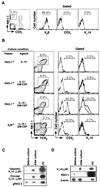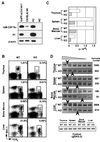Induction of differentiation of pre-NKT cells to mature Valpha14 NKT cells by granulocyte/macrophage colony-stimulating factor
- PMID: 10377433
- PMCID: PMC22104
- DOI: 10.1073/pnas.96.13.7439
Induction of differentiation of pre-NKT cells to mature Valpha14 NKT cells by granulocyte/macrophage colony-stimulating factor
Abstract
Valpha14 NKT cells express an invariant antigen receptor encoded by Valpha14 and Jalpha281 gene segments as well as natural killer (NK) markers, including NK1.1. Here, we describe a precursor population of NKT cells (pre-NKT) that expresses NK1.1, T cell antigen receptor beta, pTalpha, and RAG1/2 but not Valpha14 and surface CD3epsilon. Such pre-NKT cells were differentiated successfully in vitro into mature CD3epsilon+ Valpha14(+) NKT cells by IL-15 and granulocyte/macrophage colony-stimulating factor (GM-CSF) in conjunction with stroma cells. Interestingly, only GM-CSF without stroma cells induced the Valpha14-Jalpha281 gene rearrangement in the pre-NKT cells. This also was confirmed by the findings that the number of mature Valpha14 NKT cells and the frequency of Valpha14-Jalpha281 rearrangements were decreased significantly in the mice lacking a GM-CSF receptor component, common beta-chain. These results suggest a crucial role of GM-CSF in the development of Valpha14 NKT cells in vivo.
Figures




Similar articles
-
CD1d-specific NK1.1+ T cells with a transgenic variant TCR.J Immunol. 2000 Jul 1;165(1):168-74. doi: 10.4049/jimmunol.165.1.168. J Immunol. 2000. PMID: 10861049
-
Immediate antigen-specific effector functions by TCR-transgenic CD8+ NKT cells.Eur J Immunol. 2006 Mar;36(3):570-82. doi: 10.1002/eji.200535461. Eur J Immunol. 2006. PMID: 16506291
-
Surface receptors identify mouse NK1.1+ T cell subsets distinguished by function and T cell receptor type.Eur J Immunol. 2004 Jan;34(1):56-65. doi: 10.1002/eji.200323963. Eur J Immunol. 2004. PMID: 14971030
-
Role of alpha-galactosylceramide-activated Valpha14 natural killer T cells in the regulation of allergic diseases.Allergol Int. 2007 Mar;56(1):1-6. doi: 10.2332/allergolint.R-06-136. Epub 2007 Jan 29. Allergol Int. 2007. PMID: 17259803 Review.
-
NKT cells are relatively resistant to apoptosis.Trends Immunol. 2004 May;25(5):219-21. doi: 10.1016/j.it.2004.03.001. Trends Immunol. 2004. PMID: 15099560 Review. No abstract available.
Cited by
-
Regulation of HLA-DR and co-stimulatory molecule expression on natural killer T cells by granulocyte-macrophage colony-stimulating factor.Immunology. 2002 Jul;106(3):363-72. doi: 10.1046/j.1365-2567.2002.01446.x. Immunology. 2002. PMID: 12100724 Free PMC article.
-
Natural killer T cell ligand alpha-galactosylceramide enhances protective immunity induced by malaria vaccines.J Exp Med. 2002 Mar 4;195(5):617-24. doi: 10.1084/jem.20011889. J Exp Med. 2002. PMID: 11877484 Free PMC article.
-
Augmentation of Valpha14 NKT cell-mediated cytotoxicity by interleukin 4 in an autocrine mechanism resulting in the development of concanavalin A-induced hepatitis.J Exp Med. 2000 Jan 3;191(1):105-14. doi: 10.1084/jem.191.1.105. J Exp Med. 2000. PMID: 10620609 Free PMC article.
-
A natural killer T (NKT) cell developmental pathway iInvolving a thymus-dependent NK1.1(-)CD4(+) CD1d-dependent precursor stage.J Exp Med. 2002 Apr 1;195(7):835-44. doi: 10.1084/jem.20011544. J Exp Med. 2002. PMID: 11927628 Free PMC article.
-
Identification of CD4(-)CD8(-) double-negative natural killer T cell precursors in the thymus.PLoS One. 2008;3(11):e3688. doi: 10.1371/journal.pone.0003688. Epub 2008 Nov 10. PLoS One. 2008. PMID: 18997862 Free PMC article.
References
Publication types
MeSH terms
Substances
LinkOut - more resources
Full Text Sources
Other Literature Sources

